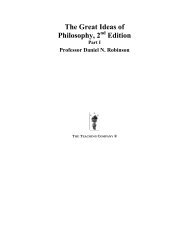English idioms in the first language and second language lexicon: a ...
English idioms in the first language and second language lexicon: a ...
English idioms in the first language and second language lexicon: a ...
You also want an ePaper? Increase the reach of your titles
YUMPU automatically turns print PDFs into web optimized ePapers that Google loves.
Beate Abel 335representations – that <strong>the</strong>re is not only a lexical, but also aconceptual level of representation, <strong>and</strong> <strong>second</strong>ly that constituent<strong>and</strong> idiom entries co-exist at <strong>the</strong> lexical level – was ga<strong>the</strong>red fromnative <strong>and</strong> nonnative judgements on <strong>the</strong> decomposability of <strong>idioms</strong>.III Judgements on <strong>the</strong> decomposability of <strong>idioms</strong>1 Native speakersGibbs <strong>and</strong> his colleagues carried out many studies on idiom decomposability(Gibbs <strong>and</strong> Nayak, 1989; Gibbs, Nayak <strong>and</strong> Cutt<strong>in</strong>g,1989; Gibbs, Nayak, Bolton <strong>and</strong> Keppel, 1989).They identified threegroups of <strong>idioms</strong>: decomposable (e.g., pop <strong>the</strong> question, break <strong>the</strong>ice, clear <strong>the</strong> air), abnormally decomposable (e.g., carry a torch, spill<strong>the</strong> beans, bury <strong>the</strong> hatchet) <strong>and</strong> nondecomposable (e.g., chew <strong>the</strong>fat, shoot <strong>the</strong> breeze, pack a punch) ones (Gibbs <strong>and</strong> Nayak, 1989:133–34). As mentioned above, <strong>in</strong> decomposable <strong>idioms</strong> <strong>the</strong>constituents contribute to <strong>the</strong> idiom’s figurative mean<strong>in</strong>g, <strong>in</strong>nondecomposable <strong>idioms</strong> <strong>the</strong>y do not. Abnormally decomposable<strong>idioms</strong> are a subgroup of decomposable <strong>idioms</strong>, ‘whose <strong>in</strong>dividualcomponents have some metaphorical relation to <strong>the</strong>ir idiomaticreferents’ (Gibbs <strong>and</strong> Nayak, 1989: 109). The results show thatdecomposable <strong>idioms</strong> are syntactically more productive, lexicallymore flexible <strong>and</strong> more quickly processed than nondecomposableones. One po<strong>in</strong>t of criticism is that <strong>in</strong> <strong>the</strong> studies reported by Gibbs<strong>and</strong> his colleagues <strong>the</strong> participants had to judge <strong>idioms</strong> that werepreselected by <strong>the</strong> authors on <strong>the</strong> basis of <strong>the</strong> three groups of<strong>idioms</strong> described above, thus imply<strong>in</strong>g a balanced distribution of all<strong>English</strong> <strong>idioms</strong> among <strong>the</strong> three groups. Titone <strong>and</strong> Conn<strong>in</strong>e (1994)had <strong>the</strong>ir participants freely comment on 171 <strong>idioms</strong> <strong>and</strong> found anasymmetrical division, i.e., <strong>the</strong>y found that native speakers of<strong>English</strong> judge 41.9% to be decomposable <strong>idioms</strong> <strong>and</strong> 58.1% to benondecomposable. Fur<strong>the</strong>rmore, <strong>the</strong>y identified some fundamentalproblems with regard to abnormally decomposable <strong>idioms</strong>: ‘subjectscannot easily make this dist<strong>in</strong>ction for all but a few idiosyncraticphrases. In contrast, <strong>the</strong> decomposable <strong>and</strong> nondecomposablesort<strong>in</strong>g task was more reliable’ (Titone <strong>and</strong> Conn<strong>in</strong>e, 1994: 262). Itseems that <strong>the</strong> subdivision of decomposable <strong>idioms</strong> <strong>in</strong>to normally<strong>and</strong> abnormally decomposable ones is of low psychological validity.The fact that <strong>the</strong> results obta<strong>in</strong>ed by Gibbs et al. differ from <strong>the</strong>f<strong>in</strong>d<strong>in</strong>gs of Titone <strong>and</strong> Conn<strong>in</strong>e led to <strong>the</strong> two studies describedbelow. In order to support <strong>and</strong> validate one or <strong>the</strong> o<strong>the</strong>r study, anonnative sample was used. On <strong>the</strong> one h<strong>and</strong>, <strong>the</strong> nonnativejudgements were exam<strong>in</strong>ed <strong>in</strong> <strong>the</strong>ir own right <strong>and</strong>, on <strong>the</strong> o<strong>the</strong>rDownloaded from http://slr.sagepub.com at Shanghai Jiaotong University on March 7, 2009














